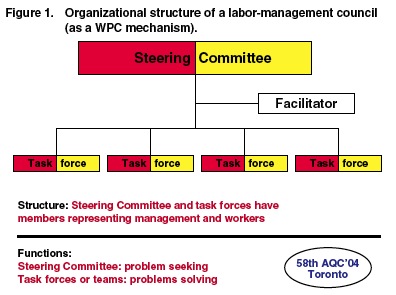 Articles
Articles
Workplace cooperation and labor management councils
 August 29,2012
August 29,2012
By: Dr. Jose C. Gatchalian, International LMC Consultant, resource speaker for the APO training course on the Development of Productivity Practitioners.
The term “workplace cooperation (WPC)” is now understood as a broad concept connoting mutual commitment between labor and management to “working together and working smarter.” Specifically, its goal is to develop an ideal situation where management and workers are full partners in identifying problems at the workplace, crafting solutions to those problems, and implementing the agreed-upon solutions.
The WPC concept encompasses an underlying philosophy and process, procedures, and organizational structure. The idea is that greater cooperation between labor and management on matters of mutual concern can create a more satisfying, productive workplace. The process involves employee participation in day-to-day decision-making that affects their jobs. The structures and procedures enable the partners to redesign work to encourage group problem solving, open information sharing, teamwork, and skill development.
Labor-management councils
As an operational mechanism for WPC, a Labor-Management Council (LMC) can be set up voluntarily by representatives of workers and management who meet to identify and resolve issues of common interest. These issues are normally separate from, and outside of, the scope of a contract or collective bargaining agreement if there is a union. Before setting up a WPC program, it is important to understand that it requires both:
- Structure, a body composed of management and labor representatives for jointly identifying, resolving, and implementing decisions on problems and issues of mutual concern to both partners (Figure 1); and
- A process of dialogue and exchange of information, leading to joint action and teamwork to address and resolve issues and problems that affect work and work relations.

Communication and participation: underlying principles of WPC
Two underlying principles generally characterize WPC: communication and participation. Industrial relations are about the interactions between workers and employers, and between their respective organizations, as influenced by government and other work-related issues. Communication lies at the very heart of employer-employee relations and therefore plays a crucial role in relationships at work. The quantity and quality of communication between management and workers at the enterprise level are significant factors in establishing and maintaining harmonious industrial relations. Information that can be shared may include daily issues that affect the company. Communication channels should ideally provide management with feedback regarding programs or policies and their implementation.
Participation, on the other hand, is a crucial component of workplace empowerment. Empowerment involves decentralizing power within the organization to individual decision makers down to the bottom rung of the workforce. It adds dynamism to the employer-employee relationship by giving workers not only a voice in decision-making on matters that affect their interest and welfare but also an opportunity to contribute creative, innovative ideas to achieve enhanced product or service quality and productivity.
At the Development Academy of the Philippines, a training course for developing productivity practitioners includes a module on the concepts, principles, and application of WPC as a basic productivity and quality improvement approach to build and sustain a strategic partnership between employees and management. Documented best practices attest to the effectiveness of the approach in institutionalizing harmonious labormanagement relations, thus facilitating productivity and quality improvement. It is increasingly realized that WPC is a vital component of strategy. Adopting it and establishing an LMC is no longer a question of “if ” or “when” but of “how.”





